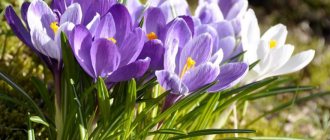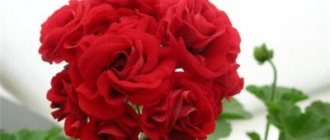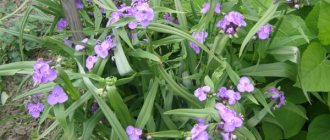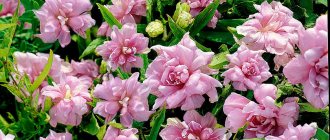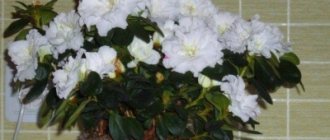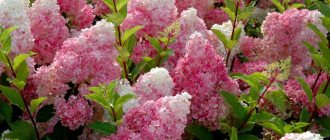Terry begonia is an amazing flower that can delight both indoor plant lovers and gardeners.
In the article we will talk about the features of terry begonia, its types, and most importantly, how to properly care for it at home.
This beautifully flowering shrub from the Begoniaceae genus has numerous carved leaves and large flowers reminiscent of small roses. The petals have a terry border at the tips, which explains the name of this flower.
Botanical description
The plant began to be grown indoors in the 17th century. The natural habitat is quite extensive - it grows in the vast expanses of Asia, Africa and America.
Currently, a lot of different varieties have been bred, differing in the shape and size of flowers, their color and cultivation characteristics. A popular variety available for sale is considered “Terry Mix Begonia ,” which is available in several colors.
As the begonia grows, it develops two unisexual flowers – male and female. Male buds have double petals, while female buds perform the function of reproduction - a seed pod is formed on them.
Most varieties feel great in open ground, where plants can be planted in late spring. With its flowering, terry begonia can delight the entire warm period, and sometimes even in winter.
Varieties
Begonia Bauer has several subspecies:
- Cleopatra;
- "Tiger";
- brindle;
- "Major";
- Apple Pie;
- Begonia Rhinestone Jeans.
Cleopatra
This variety is an ornamental plant. It has small buds, colored white or pink. They bloom from mid-winter to mid-summer.
Leaf blades can reach 15 centimeters in diameter. They are shaped like maple leaves. They have a slight fluffy coating on them.
The leaves are green with a slight bronze tint. If the flower constantly stands in an area with abundant lighting, then it will gradually change color to light brown.
Cleopatra propagates by cuttings or rooted leaves. Sometimes this is done by dividing the rhizome or even the bush itself.
"Tiger"
In this species, the leaf blades are painted bronze-green. Often this flower grows with large brown spots on the leaf blades. The leaves grow small and have a heart-shaped oblique shape. Along all the veins you can see a strip of brown tint. The stem of the plant grows branching and creeping.
Tiger
The leaf shape of this species is heart-shaped. Their edges are jagged. They are painted dark green. The pattern on the plates is presented in the form of large light green spots.
There is no aerial stem. An elongated leaf grows from the root system of the plant. The height of the entire bush can reach no more than 30 centimeters. In winter, a flowering stem grows. White flowers form on it.
"Major"
This ornamental plant has small leaves of light green color. Their edges are painted in a darker shade. You can see small bright pink spots on them. This species blooms with small pink flowers.
"Apple Pie"
This species has small dark green leaves with terry edges. On the leaf blades along the veins you can see stripes of a dark purple hue. "Apple Pie" blooms with white flowers.
Begonia Rhinestone Jeans
This variety is an ornamental small plant. The leaves are dark green with lighter edges. They have an elongated and slightly pointed shape.
Titles and photos
Terry begonia is represented by numerous subspecies, each of which has its own distinctive characteristics. Below are photos and descriptions of terry begonia varieties suitable for propagation and care at home.
Yellow
It is a small bush with recumbent, highly branching shoots, distinguished by the yellow color of the inflorescences. The flowers of yellow begonia are quite large - up to 4 cm in diameter and consist of many petals. The leaves are medium (up to 20 cm in length). The height of this variety does not exceed 50 cm. Among the popular varieties of this variety are:
- Picoti;
- Full yellow;
- Ampelous Cascade yellow (Pendula).
Red
It has red lush flowers up to 10 cm in diameter and patterned bronze leaves. The height of the plant is approximately 20-30 cm. Red begonia blooms from May to October. At the same time, you can enjoy the beauty of its flowers for 2-4 weeks. The photo below shows a red terry begonia:
Pink
Differs from other varieties with pink inflorescences. Reaches half a meter in height and is often used for planting in open ground. Pink begonia feels great in a well-lit flowerbed and, with enough fertilizer, will bloom luxuriantly from May to October . Look at the photo below to see what the terry pink variety looks like:
Scarlet
This subspecies has rich burgundy-red flowers with lush fringe along the edges and large leaves of a bronze hue. This variety looks very advantageous in a composition with other flowers, contrasting brightly against the general background. The photo below shows the terry Scarlet variety:
White
White begonia looks very delicate and elegant. The height can reach 25-30 cm. White flowers with corrugated petals are very voluminous - 10-12 cm in diameter. They have a pleasant sweet aroma. Flowering duration is 2-3 weeks.
How to plant and care for tuberous begonia at home: advice from professionals
Tuberous begonia - planting and care, the secrets of its lush long-term flowering and reproduction characteristics are of great interest to modern flower growers, since the subspecies of these flowers is a real decoration of both the garden or greenhouse, and window sills and even open terraces.
Tuberous begonia is very popular for its luxurious flowers, which come in single and double colors, in a variety of colors and shades, single, two-color or with a border along the edges. Many varieties are complex hybrids, but they all have the same requirements for growing conditions.
Care
You can get a healthy, beautifully flowering plant only by following certain rules for caring for it. We'll talk about them further.
Location and lighting
Begonia is photophilous, and therefore it needs additional lighting in the cold season. In hot weather, the flower should be protected from direct sunlight , the contact of which on the leaves can cause burns and overheating.
For symmetrical growth of the bush, the pot with begonia must be periodically rotated 180 degrees.
Watering and humidity requirements
During the period of active growth - spring and summer, the plant needs abundant watering - twice a week. In winter, you need to reduce the number of waterings by about 1.5 times.
Excessive watering can lead to the death of the plant, so make sure that the top layer of soil dries out.
Because
The tap water is too hard ; for irrigation, use settled water at room temperature.
The terry beauty will delight you with its beauty if you provide it with the necessary air humidity. For these purposes, you can use a humidifier or spray the air around the plant, preventing droplets from getting on the leaves and flowers.
A container of water located next to the pot will also help achieve the desired result.
Temperature
Terry begonia prefers an average temperature of 18-23 degrees in summer and not lower than 15 degrees in winter. The flower pot should be ventilated periodically, while protecting it from drafts and sudden changes.
Top dressing
The plant needs to be fertilized during the warm period - spring and summer, because... It is at this time that it needs additional support. Fertilizing should be done no more than 1-2 times a month . This will be enough for the full growth and strengthening of the health of the flower.
In the summer, it is better to use potassium and phosphorus fertilizers, and after winter awakening, nitrogen fertilizers.
The solution for feeding begonias should be diluted more than indicated on the package, because the flower reacts sensitively to an excess of fertilizers.
Transfer
Transplantation depends on the growth rate of the flower - if there is not enough space, it should be placed in a pot of larger diameter. Typically, replanting is carried out every two years in early spring . Tuberous varieties must be replanted annually after wintering.
Soil composition and pot
To keep begonias, it is better to purchase a clay pot with drainage holes at the bottom, which will provide oxygen access to the roots of the flower.
The plant prefers loose, slightly acidic soil with sufficient fertilizer.
You can prepare the soil yourself by including in its composition:
- 2 parts leaf soil;
- 1 part humus;
- 1 part river sand;
- 1 part peat.
If you can’t make the soil mixture yourself, you can buy a ready-made one in the store.
The plant needs a drainage layer, which must be placed at the bottom of a pot made of expanded clay or broken brick.
Frequency of pruning
It is necessary to prune when the main stem reaches 10 cm in length . It is pinched, thereby ensuring the growth of side shoots. The latter are also subject to pruning upon reaching 10-12 cm. Subsequent pruning is carried out only as needed and to give the bush the desired shape.
Decorative deciduous begonias
Flowers in this group do not have a common stem. Large leaf blades grow directly from a branched root. They come in multi-colored, speckled and plain colors. Foliage colors range from dark green to red and silver. Some representatives of this group bloom. Popular varieties and types of begonias of this species: Rex, Metallic, Red-leaved, Tiger, Coral, Diadema, Hogweed, Collared (Cuff).
Royal
Royal
These are hybrids of the Begoniaceae family. The second name is Begonia rex. The birthplace of the flower is Eastern India. The roots of the culture are creeping and powerful. The leaves are asymmetrical, heart-shaped, with a rough surface. Their color varies from green to purple. The leaf blades of most varieties have silvery spots. The stem is small, dense, covered with bristles. Peduncles are small, pink, up to 1 cm in size.
Grifon (Griffin)
Variety Grifon
- Description: the trunk is dense, creeping, the foliage is large, carved. The color of the leaves is black-green with gray splashes. The maximum plant height is 41 cm.
- Care: watering as the soil dries, regularly humidifying the air around the pot, applying fertilizers for indoor plants.
- Conditions: it is recommended to place begonia opposite a light source and shade it a little.
Escargot (Snail)
Escargot
- Description: leaf plates are asymmetrical, spherical or ovoid, twisted in a spiral. Their color ranges from purple to pink-brown, with a white, green or silver border. The surface of the foliage is matte with fine pile. The trunk is short, dense, covered with red hairs. The inflorescences are undeveloped, small, pink.
- Care: maintaining humidity at 50–60%, watering every other day in summer, as the soil dries out in winter.
- Conditions: shading from direct sunlight is required, maintaining a comfortable temperature – +20˚C in winter, and +30˚C in summer.
Tiger
Tiger
Perennial bush plant of the Begoniaceae family. The second name is Bauer (Begonia bowerae). Tiger begonia is called because of its spotted leaves. The maximum height of the bush is 30 cm. The surface of the leaf plates is fleecy. The inflorescences are inconspicuous, pale pink. The stem is straight, branching. The roots are branched, thin and tender.
Tiger
Tiger
- Description: leaves are heart-shaped with beveled serrated edges, up to 8 cm long. Their color is emerald with black and red edging, light or dark green spots. Inflorescences are small, white or pink. The trunk is creeping, branching.
- Care: moderate watering, fertilizing for indoor flowers (once a week).
- Conditions: shading from direct sunlight in spring and summer, maintaining a temperature of +16...20˚C.
Cleopatra
Cleopatra
- Description: decorative variety of indoor begonia, other names: Maple-leaved, Boveri.
- Type: bush height – 50 cm. Trunk – straight, thin, fleecy. The leaf blades are finger-shaped and pointed. Their color is olive, with white stripes, and the reverse side is burgundy. A type of root system is a rosette. The inflorescences are small, pink with a yellow center.
- Care: watering - every three days in winter, three times a month in summer.
- Conditions: temperature – +18…25˚C.
Coral
At home, begonia grows up to 1 m. The plant propagates by cuttings, dividing the rhizome. The root system is fibrous. One of the subspecies of coral begonia is Alfalfa with large, fleshy, bright pink flowers.
Alfalfa
Coral
- Description: trunk – bare, straight, leaves – wide, oval, veiny, with jagged edges. Their length is up to 20 cm, color is dark green with cream or silver splashes.
- Care: shading from direct sunlight, maintaining a temperature of +22..24˚C, watering every two days in summer, as needed in winter.
- Conditions: After flowering, the plant requires rest for at least 2 months.
A home ornamental plant native to Mexico. Its second name is Mason's begonia. The stem is creeping, thick, up to 4 cm in diameter. The leaf blades are large, up to 30 cm long. Their shape is palmately dissected, the color is dark green. The leaf lobes are round or oval, with jagged edges and veins. The flowers are small (0.5–1 cm in diameter), yellow-green, collected in racemes. This representative of the Begoniaceae family blooms from February to April.
Reproduction
You can propagate a flower in three possible ways:
- Using cuttings;
- By dividing the tuber;
- Seeds.
Let's talk about all the methods in more detail.
Propagation by cuttings
Propagation using cuttings is a fairly simple method that is suitable for all types of this plant. It is better to prune cuttings in early spring . Cuttings up to 10 cm long are suitable for propagation. The lower leaves must be removed and the cuttings placed in a container of water or soil.
When placing cuttings in water, it is better to put the container in a dark place to avoid water blooming or choose a dark container.
To speed up the appearance of roots, you can use Kornevin or another growth stimulator. Typically, roots appear within a week, after which the cuttings can be planted in the soil.
Rooting in the ground takes a little longer - after 4-5 weeks. To do this, ensure a favorable soil temperature of 20-22 degrees.
Growing from seeds
The seed method is the most difficult in comparison with the others, because
the seeds are quite small and sensitive to external factors. Seeds are planted in January. The seeds are simply sown on the surface of the soil and lightly pressed against it. The container is covered with film to create a greenhouse effect.
To get good results you will need to create the following conditions:
- Provide additional lighting to future plants (+4-5 hours of daylight), which promotes subsequent flowering already in the year of sowing.
- Maintain a temperature of 22-25 degrees.
- Regularly ventilate the container with crops.
After 2-3 weeks, the first shoots can be observed, after which the film can be gradually removed using special phytolamps.
After the formation of 3-4 leaves, they can be planted in separate pots.
Tubers
This method only applies to tuberous begonias. Large healthy tubers with 4 to 7 buds are selected for propagation.
The procedure is quite simple:
- Using a knife, the tuber is divided into parts so that each of them has buds.
- Allow the cuts to dry for several hours, and then lay the tubers with their undersides on moist soil or gauze soaked in water.
- Place the tubers in a warm, well-lit place and wait for the roots to appear.
- Place the tubers in the prepared substrate and sprinkle a little earth around them, while the upper part of the tuber should remain on the surface (2-3 cm below the edge of the pot).
- After the first shoots appear, the tuber is completely covered with earth.
- Continue care as usual.
Begonias series 'Nonstop'
Moderator: Lucina
Begonias series 'Nonstop'
Post by gya » 08 Jul 2011, 15:27
Begonias of the Non-Stop series – Begonia Non-Stop 'Nonstop'
And here is another one - tuberous begonia Non-Stop Red (Begonia Non-Stop Red). Last year, due to extreme heat, she was unable to show herself in all her glory. And now, having rested and gained strength during the dormant period, this begonia amazes with large double flowers (10 cm in diameter) of a deep red-crimson color.
Re: Begonias series 'Nonstop'
Post by Milanashka » May 28, 2013, 9:37 pm
Non Stop Begonia yellow
Re: Begonias series 'Nonstop'
Post by Olga 56 » May 30, 2013, 11:28 pm
Re: Begonias series 'Nonstop'
Post by Bergamot » Jul 17, 2014, 07:31 pm
Re: Begonias series 'Nonstop'
Post by Margarita 66 » May 11, 2015, 2:39 pm
Begonia Nonstop Rose Pitticoat. The bush is compact and lush, they promise a height of 20 cm, I have 10 so far. The first flower has a diameter of 8 cm, the second for some reason is smaller, but this is just the beginning. As the name suggests, “Nonstop” - flowering should be continuous.
Re: Begonias series 'Nonstop'
Post by Vitaly » May 11, 2015, 07:48 pm
Re: Begonias series 'Nonstop'
Post by tashtanga » May 19, 2015, 3:37 pm
Re: Begonias series 'Nonstop'
Post by Lilek » May 27, 2015, 21:55
Re: Begonias series 'Nonstop'
Post by Svyatoslav » May 27, 2015, 10:22 pm
When and how to prepare begonia tubers for the dormant period viewtopic.php?f=265&t=9405
Methods for storing begonia tubers during the dormant period viewtopic.php?f=265&t=4382
Awakening begonia tubers after a period of dormancy: how and when viewtopic.php?f=265&t=8147
We share the results of the tuber dormancy period viewtopic.php?f=265&t=7880
About the importance of the degree of awakening of tubers at the time of planting viewtopic.php?f=265&t=10414
Table of contents of the subforum “All about tuberous begonias” viewtopic.php?f=265&t=10419
This topic contains a discussion of the characteristics, flowering, etc. of begonias from the 'Nonstop' series
Begonias series 'Nonstop'
Post by lorson » 04 Jun 2016, 20:14
Begonias series 'Nonstop'
Post by Gibbs_Grom » Jun 10, 2016 9:57 pm
Begonias series 'Nonstop'
Post by Kseniya » 12 Feb 2022, 22:37
In 2016, I planted go-go and mocha and was also interested in what the difference was. I grew both varieties from seeds, the flowers and leaves of the go-go were clearly smaller. Unfortunately, the go-go did not overwinter and therefore cannot compare it with 2-year-old non-stops. Maybe it would have caught up in size.
Nonstop Mocca Pink Shades, grown from seeds, blooming in summer 2016
Begonias series 'Nonstop'
Post by Kseniya » 16 Feb 2022, 09:43
Begonia Nonstop Mocca White. Grown from seeds in 2015, like pink Mocha Pink Shades. The photo shows a flowering in 2016. Two bushes produced flowers of different structures.
One plant has a corrugated edge and long peduncles:
And the second has a smooth edge, but the flower itself is double, and looks like a rose, but the peduncles are too short, the flower is lost in the leaves.
I found a photo of Go-Go, flowering in 2016. Grown from seeds, like Nonstop, but not in 2015, but in 2016, i.e. is a first year. In this case, the flower is fully formed, but the size is 2 times less than that of Nonstop.
{SOURCE}
Diseases and pests
Common diseases characteristic of the terry variety are:
- Gray rot, which appears from an excess of moisture in the room and lack of heat. In this case, the plant becomes covered with mold, which can be dealt with by spraying with special preparations. The affected areas of the flower should be carefully removed. It is also important to regularly ventilate the room if the begonia is kept indoors.
- Powdery mildew. The cause of this disease is frequent temperature changes, the presence of drafts and excess moisture. Outdoor plants are at risk. The disease is treated by treating with fungicides.
In addition to diseases associated with improper living conditions, pests also pose a danger . Among them are often found:
- A spider mite that entangles a plant and feeds on its juices. To get rid of a tick you will need a soap solution.
- Aphid. It also often attacks terry begonia, and getting rid of it is quite difficult - you will need to treat the flower with insecticides every day until the pests completely disappear.
Photo gallery
favorite_flower_kz
rastenia_ot_kateriny
rastenia_ot_kateriny
rastenia_ot_kateriny
